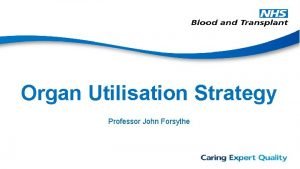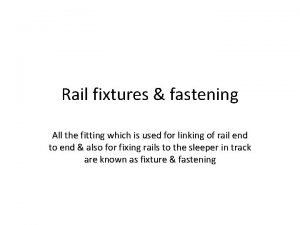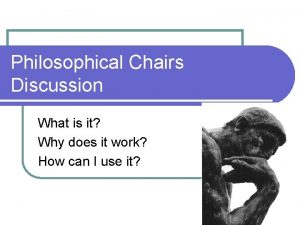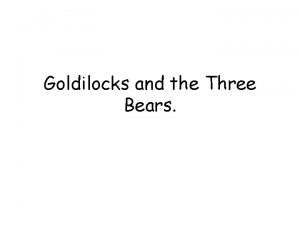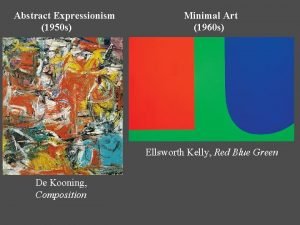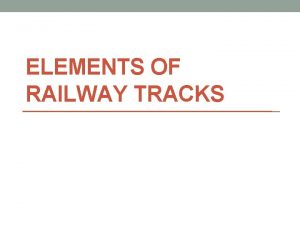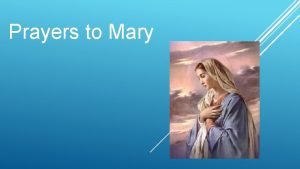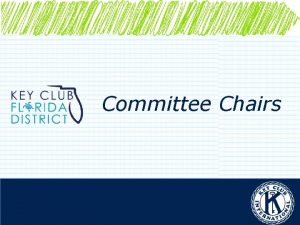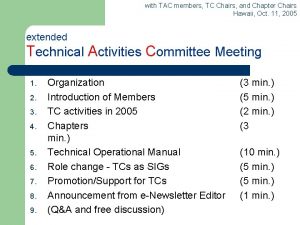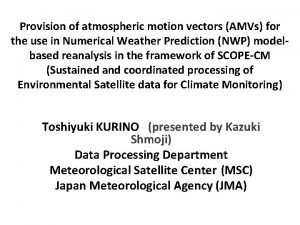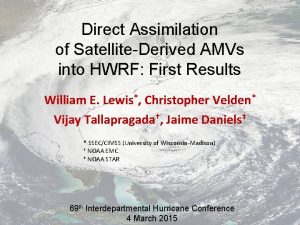Which AMVs for which model Chairs Mary Forsythe




















- Slides: 20

Which AMVs for which model? Chairs: Mary Forsythe, Roger Randriamampianina IWW 14, 24 April 2018

Thanks to • Regis Borde, EUMETSAT • James Cotton, Met Office • Javier Garcia-Pereda, NWC SAF • Graeme Kelly, Met Office • Kenichi Nonaka, JMA • Ad Stoffelen, KNMI • Chris Velden, CIMSS For contributing material and thoughts on this topic

1. Motivation 2. NWP requirements 3. Considerations for AMV production

Motivation • Most current AMV products capture broad-scale to synopticscale flow. GOES-12 GOES-14 • Can see information available on smaller scales in the imagery. • Spatial and temporal resolution improving e. g. Himawari-8. GOES -16, MTG • Can we derive more useful AMV information for nowcasting or assimilation in high resolution models? Particularly to help with forecasting high impact weather events. Visible data from the GOES-14 NOAA Science Test – 1 min imagery, from Jaime Daniels, NESDIS

Motivation Oyama et al. , 2018, JMSJ

Motivation AMVs are an important part of the observing system for global NWP – see in FSOI and data denial studies James Cotton, Met Office

Motivation We also know wind information is increasingly important as move to higher resolution to capture and initialize smallamplitude, fast-evolving and mesoscale dynamical structures. Divergent part of the wind is no longer considered “noise”, it is the needed “signal” In NWP smaller scales tend to change fast and represent only modest energy conversion. The 4 D quantity and coverage of observations to initialise and evolve these scales is a daunting challenge. Inadequate coverage could compromise the analysis of the larger scales. Challenge to improve winds part of the Global Observing System to meet these requirements. Ad Stoffelen, KNMI

1. Motivation 2. NWP requirements 3. Considerations for AMV production

What are the use cases we need to consider? • Global NWP • Regional NWP • Nowcasting / diagnostic studies? Are the requirements different? Ad Stoffelen, KNMI

Different models – different requirements? Met Office Global Model 10 km resolution Runs every 6 hours 6 hour assimilation window Met Office UKV Model 1. 5 km resolution (over core area) Runs every hour 1 hour assimilation window Stricter obs timeliness requirements Tom Blackmore, Met Office

Effective model resolution Several studies have looked at effective model resolution - some differences in both the approach and results, but agree it is several times the grid resolution. Gert-Jan Marseille et al. , 2013 (ESA Aeolus study) • Spectral analysis using collocated observations (scatterometer, MODE-S winds) and model background winds. • ECMWF grid resolution = 16 km, effective model resolution of 200 -500 km. • Note also that model underestimates vertical shear by a factor of 2 -3 • Conclude that Aeolus and scatterometer resolutions of 80 -100 km may be fairly optimal for global model. Saleh Abdalla et al. , 2012 (ESA Aeolus study) • Calculated kinetic energy spectra using 12 hr forecast fields • ECMWF grid resolution = 16 km, effective model resolution of 100 km, partially below that. There has been less work done with high resolution regional models…. . We expect the effective resolution will be higher, but perhaps not by as much as you might think.

Timeliness requirements • Global models – in some cases use data up to 3 -9 hr old (end-start of assimilation window) in update runs, up to 0 -5. 5 hr old in main forecast runs • Regional models – moving towards hourly cycling with shorter cut-offs - UKV use data up to 15 -75 min old New section on NWP SAF web site showing data coverage plots and data timeliness plots. Initial version available; plans for further development https: //www. nwpsaf. eu/site/monitoring/nrt-availability/ NWP SAF

AMV error correlations • UKWINDS (NWC SAF) vs UKV model – Desroziers method, 20 km bin • Horizontal correlations ~140 -210 km – low level smallest correlations, mid level highest correlations • Vertical correlations for IR ~150 km • Temporal correlations – some levels not dropped below 0. 2 after 3 hrs. Graeme Kelly, Met Office

Decisions for NWP • We know that 1. The AMV data has correlated errors, if we assimilate at too high density we risk overfitting to the data. If we thin too much, we risk losing the mesoscale information of interest 2. We could allow for correlated error in the assimilation, this tends to assume a simplified correlation falling off with distance, not clear yet how well this would work. 3. If we cannot adequately initialise the smaller turbulent scales we risk compromising the analysis of the larger scales 4. Models not able to resolve some of the smaller scale features. • As a result are we better to try to match the scales we think we can adequately initialise and resolve in the models by either super-modding or superobbing the data? This may vary geographically. • Correlated error is often handled by either thinning or superobbing the data and potentially also inflating the errors. • What do we do in more interesting regions including near tropical cyclone – should we attempt to assimilate at higher density in these areas despite the challenges, but assimilating the data at lower density elsewhere to reduce the risks of overfitting the data?

EUMETSAT NWP SAF mesoscale wind data assimilation workshop Tallinn, Estonia, half a day, during the EUMETSAT Conference 17 to 21 September 2018 – exact date to be confirmed soon Topics covered include: • Spatial scales observed and the errors in satellite winds • Examples of the spatial scales deterministically modelled, but also the spatial scales which are only realistically modelled and not well initialized. • Spatial representation errors, which often dominate wind measurement observation errors. The pros and cons of thinning, superobbing and “supermodding” will be discussed. • Bias correction If you want to be kept up-to-date on this workshop, please register at scat@knmi. nl for the workshop.

1. Motivation 2. NWP requirements 3. Considerations for AMV production

How do we optimize the production and the assimilation? • Temporal image interval • Target size • Cross-correlation or optical flow • AMV grid resolution (avoid overlapping targets? ) • How often should they be produced Some other considerations for deriving HR AMVs • More sensitive to satellite image registration errors (but navigation systems are improving). • Cannot resolve slower winds well with shorter image intervals (less of a problem for high resolution visible channels). • Current quality indicators tuned to large-scales - penalize spatially varying, accelerating wind features - need new quality control – could use other information from derivation.

High resolution AMVs – some thoughts Use smaller targets and shorter imager intervals to derive high resolution AMV datasets reflecting the motion of smaller scale features of the flow. Tracking – becomes trickier Example correlation surface with 5 x 5 pixel targets. BUT more noise - many peaks -> Information included in target feature is not enough to determine wind vector accurately From Kazuki Shimoji’s IWW 12 talk Need to reduce noise • clustering (e. g. Nested tracking developed at NESDIS) • use information from correlation surface to filter out poorly constrained cases. • averaging (see e. g. Shimoji, IWW 12)

Beyond NWP - visualisation and nowcasting Potential use for severe weather e. g. • Tropical cyclone studies - Oyama et al, JMSJ, 2018 • Convective weather events – Apke et al. , JAMC, 2016 2337 UTC 20 May 2014 example of supercell in central Colorado – associated with hail up to 6 -7 cm in diameter (c) Current 7 -min GOES rapid scan m. AMVs as compared with (d) 1 -min GOES-14 super rapid scan–derived m. AMVs with GOES visible imagery. GOES visible satellite data with equilibrium-level flow-relative SRSOR m. AMVs and (left) cloud top divergence and (right) cloud top vorticity Distinct signal in divergence and vorticity (couplet pattern) for supercell cases – potential for severe weather prediction. But, more work needed to QC the data (problems near cloud edges, cirrus contamination…)

And finally… We can continue to use the wiki page on IWWG web page to foster collaboration https: //groups. ssec. wisc. edu/groups/iwwg/activities/high-resolution-winds-1/high-resolution-winds
 Professor john forsythe
Professor john forsythe Professor john forsythe
Professor john forsythe Sndusrmsg
Sndusrmsg Frank forsythe
Frank forsythe Pressors icu
Pressors icu Mary wollstonecraft mary a fiction
Mary wollstonecraft mary a fiction Ucla endowed chairs
Ucla endowed chairs Rail fixtures and fastenings slideshare
Rail fixtures and fastenings slideshare Planmeca compact i classic
Planmeca compact i classic Philosophical chairs rules
Philosophical chairs rules Philosophical chairs rules of engagement
Philosophical chairs rules of engagement Topics for philosophical chairs
Topics for philosophical chairs Goldilocks and the three bears scene
Goldilocks and the three bears scene One and three chairs
One and three chairs One and three chairs
One and three chairs Wearable chairs
Wearable chairs Avid philosophical chairs
Avid philosophical chairs Philosophical chairs topics
Philosophical chairs topics Soil health
Soil health Double headed rail advantages and disadvantages
Double headed rail advantages and disadvantages Mun policy statement example
Mun policy statement example

